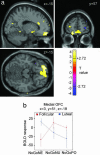Orbitofrontal cortex activity related to emotional processing changes across the menstrual cycle
- PMID: 16247013
- PMCID: PMC1276043
- DOI: 10.1073/pnas.0502818102
Orbitofrontal cortex activity related to emotional processing changes across the menstrual cycle
Abstract
The orbitofrontal cortex (OFC) has been implicated in the representation of emotional stimuli, assignment of emotional valence/salience to stimuli, stimulus-reinforcement association learning, motivation, and socio-emotional control. Using functional magnetic resonance imaging in female subjects without premenstrual mood symptoms, we found that OFC activity to emotional linguistic stimuli varies depending on the menstrual cycle phase. Specifically, anterior-medial OFC activity for negative vs. neutral stimuli was increased premenstrually and decreased postmenstrually. The inverse pattern was seen in the lateral OFC. These findings suggest that specific subregional OFC activity to emotional stimuli is modulated across the menstrual cycle. The data also demonstrate that menstrual cycle phase is an important consideration in further studies attempting to elucidate the neural substrates of affective representation.
Figures



Similar articles
-
Toward a functional neuroanatomy of premenstrual dysphoric disorder.J Affect Disord. 2008 May;108(1-2):87-94. doi: 10.1016/j.jad.2007.09.015. Epub 2007 Nov 26. J Affect Disord. 2008. PMID: 18031826
-
Menstrual cycle phase modulates emotional conflict processing in women with and without premenstrual syndrome (PMS)--a pilot study.PLoS One. 2013 Apr 24;8(4):e59780. doi: 10.1371/journal.pone.0059780. Print 2013. PLoS One. 2013. PMID: 23637739 Free PMC article.
-
Sex differences during emotion processing are dependent on the menstrual cycle phase.Psychoneuroendocrinology. 2019 Feb;100:85-95. doi: 10.1016/j.psyneuen.2018.09.032. Epub 2018 Oct 5. Psychoneuroendocrinology. 2019. PMID: 30296706
-
Premenstrual dysphoric disorder and prefrontal reactivity during anticipation of emotional stimuli.Eur Neuropsychopharmacol. 2013 Nov;23(11):1474-83. doi: 10.1016/j.euroneuro.2013.08.002. Epub 2013 Aug 17. Eur Neuropsychopharmacol. 2013. PMID: 24001875
-
Effect of the different phases of the menstrual cycle and oral contraceptives on athletic performance.Sports Med. 1993 Dec;16(6):400-30. doi: 10.2165/00007256-199316060-00005. Sports Med. 1993. PMID: 8303141 Review.
Cited by
-
Sex differences in orbitofrontal connectivity in male and female veterans with TBI.Brain Imaging Behav. 2015 Sep;9(3):535-49. doi: 10.1007/s11682-015-9379-3. Brain Imaging Behav. 2015. PMID: 25864195 Free PMC article.
-
MR diffusion tensor imaging detects rapid microstructural changes in amygdala and hippocampus following fear conditioning in mice.PLoS One. 2013;8(1):e51704. doi: 10.1371/journal.pone.0051704. Epub 2013 Jan 30. PLoS One. 2013. PMID: 23382811 Free PMC article.
-
Menstrual cycle phase modulates reward-related neural function in women.Proc Natl Acad Sci U S A. 2007 Feb 13;104(7):2465-70. doi: 10.1073/pnas.0605569104. Epub 2007 Jan 31. Proc Natl Acad Sci U S A. 2007. PMID: 17267613 Free PMC article.
-
Facial emotion recognition and amygdala activation are associated with menstrual cycle phase.Psychoneuroendocrinology. 2008 Sep;33(8):1031-40. doi: 10.1016/j.psyneuen.2008.04.014. Psychoneuroendocrinology. 2008. PMID: 18675521 Free PMC article. Clinical Trial.
-
Fetal hormonal programming of sex differences in depression: linking women's mental health with sex differences in the brain across the lifespan.Front Neurosci. 2014 Sep 8;8:247. doi: 10.3389/fnins.2014.00247. eCollection 2014. Front Neurosci. 2014. PMID: 25249929 Free PMC article. No abstract available.
References
-
- Dolan, R. J. (1999) Nat. Neurosci. 2, 927-929. - PubMed
-
- Damasio, A. R., Tranel, D. & Damasio, H. (1990) Behav. Brain Res. 41, 81-94. - PubMed
-
- Mitchell, D. G., Colledge, E., Leonard, A. & Blair, R. J. (2002) Neuropsychologia 40, 2013-2022. - PubMed
-
- Price, B. H., Daffner, K. R., Stowe, R. M. & Mesulam, M. M. (1990) Brain 113, 1383-1393. - PubMed
-
- Elliott, R., Dolan, R. J. & Frith, C. D. (2000) Cereb. Cortex 10, 308-317. - PubMed
Publication types
MeSH terms
Grants and funding
LinkOut - more resources
Full Text Sources
Other Literature Sources

